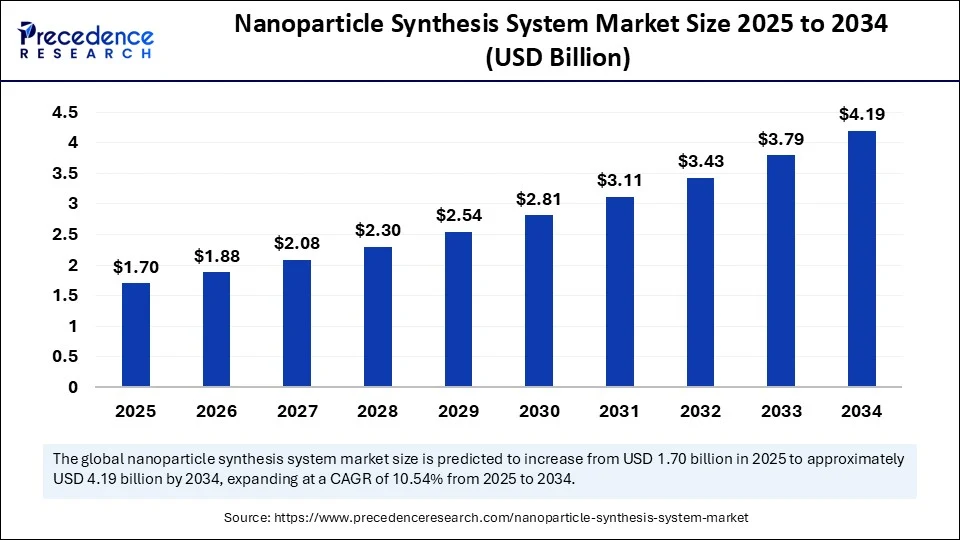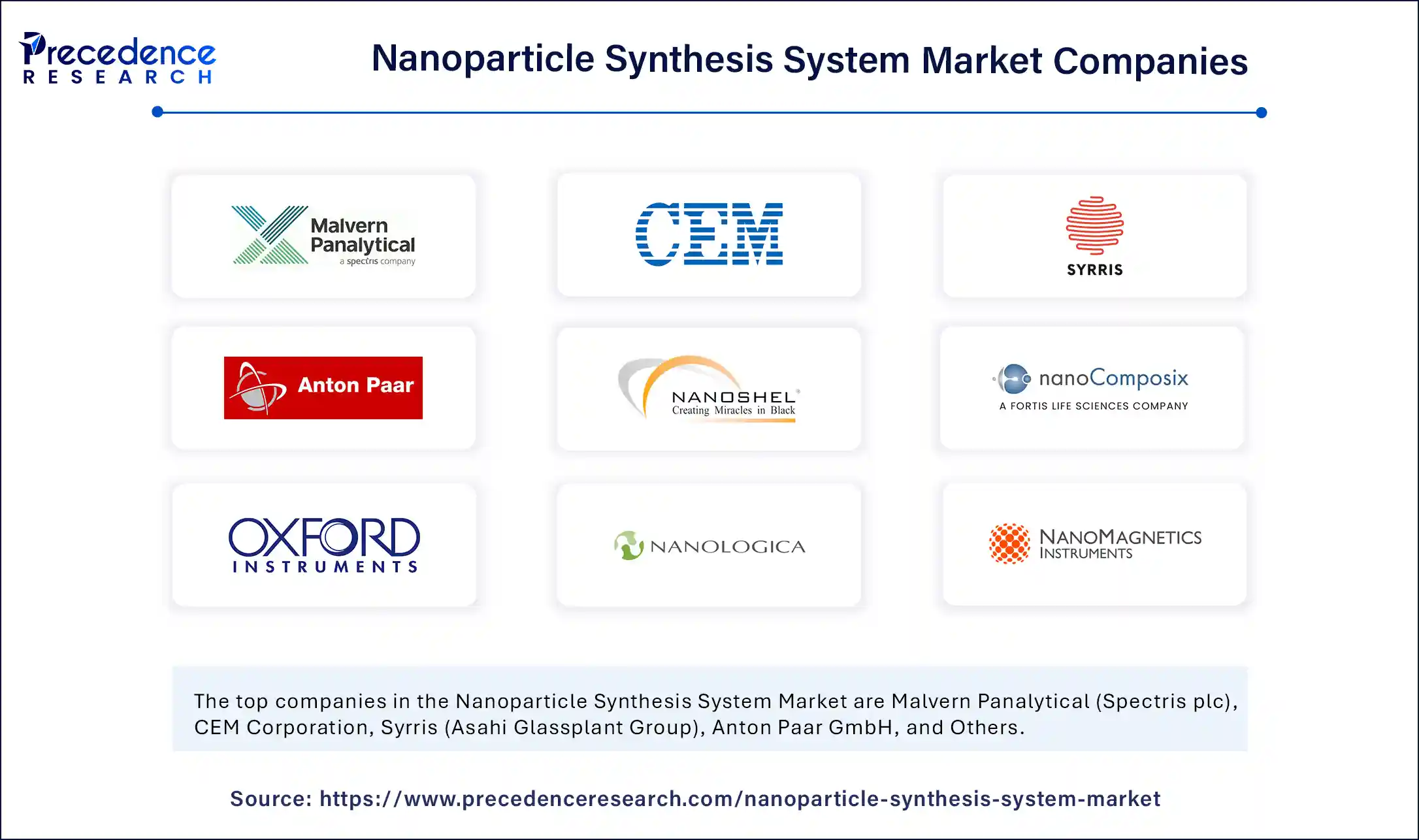
Key Market Takeaways
-
Regional leadership: North America retained the largest revenue share in 2024, supported by deep R&D funding and an established nanotech supply chain. Asia‑Pacific, propelled by China, Japan, South Korea and India, is poised to register the fastest CAGR through 2034.
-
Technology mix: Chemical‑reduction systems dominated 2024, while microfluidic (continuous‑flow) platforms are forecast to be the quickest‑growing technology thanks to precise process control and scalability.
-
Scale of operation: Laboratory‑scale units account for the bulk of current installations, yet industrial‑scale systems will outpace all others as manufacturers move toward high‑volume, cost‑efficient production.
-
Material focus: Metallic nanoparticles hold the largest share today; demand for carbon‑based nanostructures (graphene, CNTs, fullerenes) is rising fastest on the back of energy‑storage and electronics applications.
-
End‑use profile: Pharmaceuticals & biotechnology lead revenues, whereas the energy sector (battery, fuel‑cell, PV) promises the steepest growth curve.
How Is Artificial Intelligence Transforming the Market?
Artificial Intelligence (AI) is increasingly becoming a transformative force in the nanoparticle synthesis system market. AI technologies are enabling self-optimizing, closed-loop synthesis platforms that significantly reduce experimental time and human error.
For instance, in 2025, researchers in the UK demonstrated a cloud-connected, AI-driven lab for polymer nanoparticle production that could autonomously adjust synthesis parameters like temperature, flow rate, and pH, reducing optimization cycles from weeks to hours. Moreover, AI-powered predictive analytics tools are being integrated into synthesis equipment to forecast nanoparticle properties, detect process anomalies, and guide preventive maintenance, which improves reliability and efficiency.
Additionally, machine learning algorithms are being utilized to simulate and predict nanoparticle behavior, allowing researchers to virtually test thousands of formulations before conducting physical experiments. These AI capabilities are not only enhancing product quality but also pushing the boundaries of innovation by enabling more complex, custom-designed nanoparticles for personalized medicine, next-generation displays, and green energy applications.
What Is the Market Overview and Core Application Scope?
Nanoparticle synthesis systems are specialized platforms used to produce nanoparticles—ultra-small particles with dimensions typically between 1 and 100 nanometers. These systems consist of reactors (batch, microfluidic, or continuous flow), synthesis modules (chemical, physical, or biological), control software, and analytical tools such as UV-Vis, DLS, and TEM for real-time monitoring.
The market supports a wide range of materials, including metallic (gold, silver), polymeric, lipid-based, ceramic/oxide, and carbon-based (graphene, carbon nanotubes) nanoparticles. These particles are widely used in drug delivery systems, cancer treatment, imaging agents, photovoltaic cells, semiconductors, water purification, and food safety applications. As industries seek smaller, more functional materials, the demand for precision-engineered nanoparticles and reliable synthesis systems continues to expand.
What Are the Major Drivers Fueling Market Growth?
Several pivotal factors are driving the rapid growth of the nanoparticle synthesis system market. First, the explosion of nanomedicine and precision therapeutics, especially in mRNA delivery and cancer immunotherapy, is increasing the need for sophisticated lipid and polymeric nanoparticle platforms. Second, growing demand for nano-enabled electronics, such as quantum dot displays and transistors, is encouraging investment in high-throughput synthesis systems.
Third, global emphasis on sustainable energy solutions, including fuel cells, batteries, and solar cells that utilize nanostructured materials, is expanding the energy sector’s appetite for nanoparticles. Additionally, there is growing interest in environmental remediation, where metal oxide and carbon nanoparticles are being used for pollutant degradation and water purification. Finally, national-level R&D funding and public-private partnerships—especially in the U.S., China, EU, and India—are significantly boosting nanomanufacturing capabilities and market expansion.
What Are the Market Dynamics Influencing Growth?
The nanoparticle synthesis system market is shaped by a dynamic interplay of growth drivers, challenges, and emerging opportunities. Among the key drivers are the increasing adoption of continuous flow microfluidic systems, which reduce waste and allow precise control of particle size and composition, and the rising push for green synthesis methods using biological agents like plant extracts and enzymes.
However, the market also faces restraints, such as the high capital costs of advanced synthesis platforms and the technical complexity associated with multi-parameter control and scale-up, which can deter smaller players and research labs. Additionally, a shortage of skilled professionals trained in nanoparticle manufacturing remains a concern. On the opportunity front, there’s growing demand for customizable nanoparticles tailored for specific biomedical applications, as well as increasing integration of AI and IoT technologies to automate and monitor synthesis processes remotely. These trends are opening new doors for innovation and market differentiation.
Nanoparticle Synthesis System Market Scope
| Report Coverage | Details |
| Market Size by 2034 | USD 4.19 Billion |
| Market Size in 2025 | USD 1.70 Billion |
| Market Size in 2024 | USD 1.54 Billion |
| Market Growth Rate from 2025 to 2034 | CAGR of 10.54% |
| Dominating Region | North America |
| Fastest Growing Region | Asia Pacific |
| Base Year | 2024 |
| Forecast Period | 2025 to 2034 |
| Segments Covered | Technology Type, Scale of Operation, End-Use Industry, Material Type Synthesized, and Region |
| Regions Covered | North America, Europe, Asia-Pacific, Latin America, and Middle East & Africa |
Which Segments Are Leading the Market and Why?
The market can be segmented by technology, scale of operation, material/product type, and end-use industry. In terms of technology, chemical reduction systems hold the dominant share due to their well-established protocols and cost-effectiveness, but microfluidic synthesis systems are expected to grow fastest due to their ability to produce nanoparticles with narrow size distributions and high reproducibility.
Regarding scale of operation, laboratory-scale units dominate as they are prevalent in academic and pharmaceutical R&D, but industrial-scale systems are set to rise significantly as mass production of nanoparticles becomes a reality, especially in pharma and energy. For material types, metallic nanoparticles such as silver and gold lead due to their antimicrobial and optical properties, but carbon-based nanoparticles, like graphene and carbon nanotubes, are witnessing the highest growth rate due to their application in electronics and supercapacitors. Among end-use industries, pharmaceuticals and biotechnology currently lead the market due to increasing adoption in drug delivery and imaging, while the energy sector is projected to grow most rapidly, driven by nano-enabled energy storage and generation technologies.
How Does the Market Perform Across Regions?
Regionally, the North American market dominates, backed by substantial R&D investments, a strong academic-industrial ecosystem, and robust regulatory frameworks that encourage innovation in nanotechnology. The U.S. remains a key leader, supported by agencies like the NIH, DOE, and DARPA.
Europe follows closely, with major contributions from Germany, the UK, and France, emphasizing sustainable nanomanufacturing and quantum technologies.
Asia-Pacific is projected to be the fastest-growing region, owing to significant government support, low manufacturing costs, and rapid infrastructure development. China, Japan, South Korea, and India are spearheading growth through initiatives like China’s Nanotech Action Plan and India’s “Make in India” nanotech push.
In Latin America, countries like Brazil and Chile are emerging as niche players, with investments in nanomedicine and energy materials. The Middle East & Africa region, while still nascent, is beginning to see research investments in solar nanomaterials and mining applications in countries like UAE and South Africa.
Who Are the Major Industry Players and What Are Their Latest Developments?
Several key companies are shaping the competitive landscape of the nanoparticle synthesis system market. Malvern Panalytical (a Spectris company) has strengthened its portfolio with advanced nanoparticle characterization tools and hosted industry forums focused on applied nanoscience.
Dolomite Microfluidics, a Blacktrace company, introduced new continuous-flow platforms capable of synthesizing highly uniform nanoparticles at lab and pilot scales.
CEM Corporation is leveraging microwave-assisted systems for faster synthesis of metal nanoparticles, integrated with AI modules.
Anton Paar has entered the semiconductor space with modular laser ablation systems for high-purity oxide nanoparticle generation.
NanoComposix, now part of Fortis Life Sciences, opened a GMP facility in 2025 for custom gold nanoparticle formulations, catering to both diagnostic and therapeutic markets. These developments indicate a trend toward modularity, precision, and AI-assisted processing across leading vendors.

- Malvern Panalytical (Spectris plc)
- CEM Corporation
- Syrris (Asahi Glassplant Group)
- Anton Paar GmbH
- Nanoshel LLC
- NanoComposix (Fortis Life Sciences)
- Oxford Instruments plc
- Nanologica AB
- NanoMagnetics Instruments
- ELICITYL SA
- NanoEnTek Inc.
- Blacktrace Holdings Ltd.
- Sona Nanotech Inc.
- Izon Science Ltd.
- Strem Chemicals (part of Ascensus)
- Nanonics Imaging Ltd.
- Avestin Inc.
- Dolomite Microfluidics
- PlasmaChem GmbH
- Mknano (M K Impex Corp)
What Are the Most Noteworthy Recent Developments?
- In June 2025, Oregon State University researchers developed a lipid nanoparticle-based gene delivery platform specifically targeting lung tissue, which has potential in treating genetic respiratory disorders. In
- February 2025, a collaborative project among Cornell, Arizona State, and the University of Iowa used high-resolution imaging to study nanoparticle behavior in real time, improving synthesis model accuracy.,
- In April 2025, UK researchers at the University of Leeds launched a self-driving lab equipped with AI and cloud computing that autonomously optimized polymer nanoparticle synthesis, achieving time savings of over 90%. These milestones underscore the market’s ongoing transition toward automation, AI integration, and tailored nanoparticle production.
How Is the Market Segmented Structurally?
The market is segmented as follows:
-
By Technology Type:
-
Chemical Reduction Systems
-
Microfluidic Synthesis Systems
-
Sol-Gel Process Systems
-
Laser Ablation Systems
-
Plasma Synthesis Systems
-
Biological/Green Synthesis Systems
-
Other Techniques (PVD, Electrochemical Methods)
-
-
By Scale of Operation:
-
Laboratory Scale
-
Pilot Scale
-
Industrial Scale
-
-
By Material/Product Type:
-
Metallic Nanoparticles
-
Polymeric Nanoparticles
-
Lipid-based Nanoparticles
-
Ceramic/Oxide Nanoparticles
-
Carbon-based Nanoparticles
-
-
By End-use Industry:
-
Pharmaceuticals & Biotechnology
-
Electronics & Semiconductors
-
Energy
-
Cosmetics & Personal Care
-
Environmental Applications
-
Academic & Research Institutions
-
Food & Agriculture
-
-
By Region:
-
North America
-
Europe
-
Asia-Pacific
-
Latin America
-
Middle East & Africa
-
Read Also: Pharmacovigilance and Drug Safety Software Market
You can place an order or ask any questions, please feel free to contact at sales@precedenceresearch.com |+1 804 441 9344